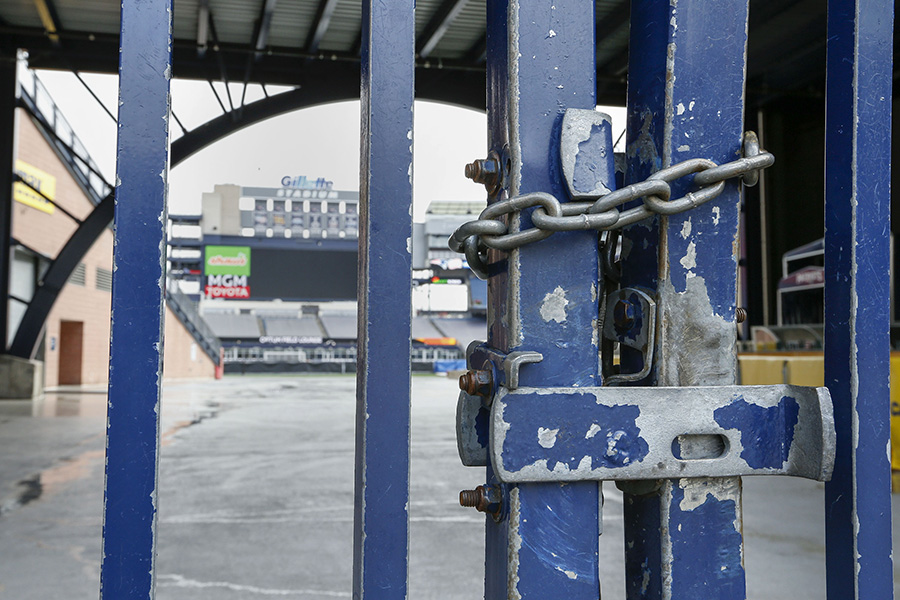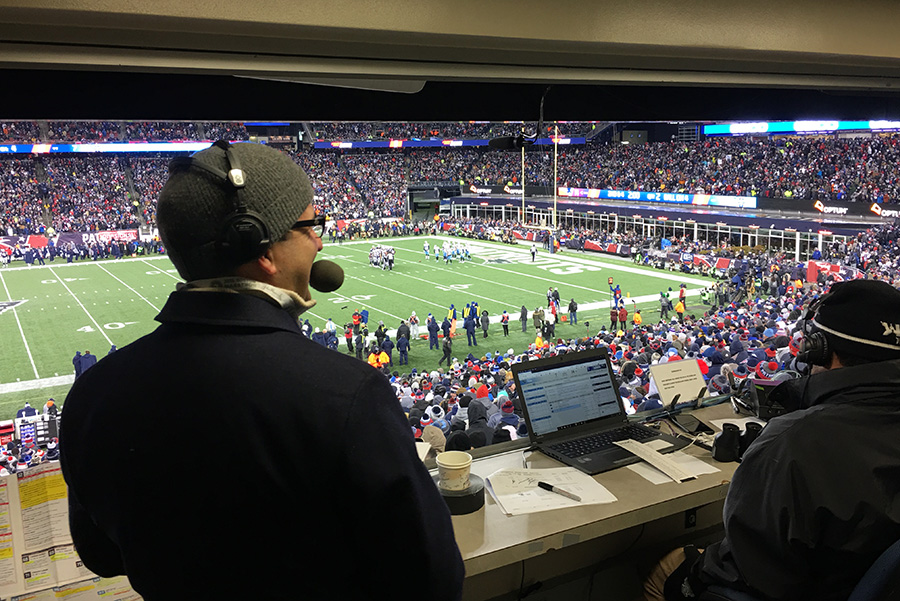What would an NFL bubble look like?
By Alex Barth, 985TheSportsHub.com
The NFL is going to attempt to play its 2020 season outside of a bubble, with teams flying all over the country for 4-plus months. But, as we learned yesterday from Major League Baseball, that may not be a realistic plan.
Following a large number of positive tests among the Miami Marlins, ESPN’s Kevin Seifert reports that the NFL has no plans to adapt a bubble format at this time.
But as we’ve learned in the last four months, things can change very quickly in the time of COVID-19. What if the NFL had no choice but to move games into a bubble? What would that look like?
It wouldn’t be as easy as the NBA or NHL, given that games only happen once a week and usually take longer. Still, it’s not impossible. Here’s one possible plan for the 2020 NFL bubble…
Setup

Would an “NFL bubble” be the only way of getting through the entire 2020 football season? (Photo by Alex Burstow/Getty Images)
The league would be split into four bubbles, with geographic divisions paired across conferences. For example, the AFC East and NFC East would be one bubble, the AFC North and NFC North another.
Team Schedules
Quarantining teams by region would necessitate a new regular season schedule. So in this scenario, each team will play a 15-week, 14-game slate, facing off against each member of their bubble twice. Four bye weeks will be put into the middle of the schedule, weeks 4-11, with four teams (two pairs from separate bubbles) given the week off at a time.
The two weeks taken off of the typical NFL schedule would be used at the beginning, to allow everybody to fully quarantine before practices begin.
Location

One possible route that could be taken in an NFL bubble is to quarantine teams by geographic region. (Greg M. Cooper-USA TODAY Sports)
Teams would finish a quarantined training camp at their individual locations before reporting to their respective bubbles. The locations of each NFL bubble were picked based on a number of criteria. First off, they had to be in areas that have had a limited COVID-19 impact.
A turf field is also important, since each stadium will see multiple practices/games a day. It’s not realistic to expect a grass field to be maintained, given the schedule.
An abundance of hotels in the area is also a necessity. Ideally, each team would have its own hotel, similar to the Super Bowl.
Finally, indoor stadiums are given preference. This plan doesn’t have much wiggle room when it comes to the schedule, so the fewer cancelations/postponements due to weather, the better. Because there will be no fans in attendance, seating capacity is irrelevant, although those with multiple locker rooms are helpful.
With all that in mind, the four bubbles would be:
East Bubble: Syracuse, N.Y. (Carrier Dome)
West Bubble: St. Louis, Mo. (The Dome at America’s Center, formerly Edward Jones Dome)
North Bubble: Indianapolis, Ind. (Lucas Oil Stadium)
South Bubble: Birmingham, Ala. (Legion Field)
Of those four cities, three have seen less than 4,000 total COVID cases since the pandemic began. Indy’s number is slightly higher (over 13,800), but there are hotels and restaurants accessible from the stadium without going outdoors, which would make it easier to quarantine those involved.
Other cities considered were Detroit, Buffalo, Seattle, San Diego, Honolulu, and Fargo.
Rosters

A detailed view of the helmets of New England Patriots prior to the game against the New York Giants at Gillette Stadium on October 10, 2019 in Foxborough, Massachusetts. (Photo by Maddie Meyer/Getty Images)
The current plan is for 2020 is for NFL teams to have the usual 53-man roster, with an expanded 16-player practice squad. Each team would bring those 69 players to the bubble, with 48 allowed to be active for each game. Teams would be allowed to move players freely between their main roster and practice squad to account for things such as injuries and positive COVID tests.
COVID testing and safety protocols for all involved (players, coaches, etc.) would remain in place as they’ve already been agreed to.
Practices
Each team will have team facilities like weight rooms, film rooms, etc. set up in their hotel. Most of what is done in a day at a team’s facility under normal circumstances can be done without leaving the bubble.
In terms of actual practice, each team will be given a two-hour access window (the longest daily practice time allowed by the CBA) to the field at their bubble location, starting at 8 a.m. and ending at midnight.
Game/Broadcast Schedules

Bob Socci of 98.5 The Sports Hub calls the action as the New England Patriots take on the Tennessee Titans in the 2017 AFC Divisional Playoff at Gillette Stadium in Foxborough, Mass. on Jan. 13, 2018. (Matt Dolloff/WBZ-FM)
Each bubble will need to play four games a week (three if teams have a bye).
In order to maximize exposure without piling games on top of each other, there’s two plans for how the games would be scheduled. One if college football goes through with starting in September (Plan A), and a second if there is no college football (Plan B).
Plan A
Each bubble will play three games on Sundays, with kickoffs at noon, 4:15, and 8:30. If games run long, following games will be pushed back, like March Madness.
The fourth game each week will be played in a primetime slot that rotates between the different bubbles. Primetime slots will be a Thursday night game, Friday night game, and two Monday night games (7 p.m., 10 p.m.).
Plan B
If there is no college football and Saturdays are available, the NFL can spread out their games a bit more. Each bubble would have a Saturday afternoon game (1 p.m.), then two Sunday games (2 p.m., 7p.m.). The primetime games would be spread out one each on Thursday, Friday, Saturday, and Monday night.
In terms of fulfilling broadcast contracts, CBS could be given the rights to two bubbles, Fox to the two others. The primetime games would be divided up by bubble between CBS, Fox, NBC, and ESPN.
Only those who need to be on-site for the broadcast would be allowed, and quarantined in the respective bubble. Announcers, etc. would call games from their studios like other sports are doing.
Playoffs

Can we get all the way to the Super Bowl without an NFL bubble? (Photo by Kevin C. Cox/Getty Images)
At the end of the regular season schedule, the top-2 teams in each bubble would play each other to determine the bubble’s champion. The four remaining teams would then be seeded based on record 1-4 (with opponent winning-percentage used as a tiebreaker).
Those four teams would meet for two semifinal games (1 vs. 4, 2 vs. 3), with the winners meeting in the Super Bowl.
Those games would take place in yet another bubble at a to-be-determined location, depending on how the COVID situation looks at the end of December. The existing bubble sites could be considered. Tampa (who is scheduled to host the Super Bowl this year) could be a suitor, as well as other locations meeting the earlier criteria (such as Dallas or Atlanta), if they have the virus relatively under control by then.
Remaining Questions
The bulk of remaining questions involve medical issues. What happens if a significant number of players on one team test positive? How does cancelling/postponing games work? Can a team be removed from the season?
The reality is the NFL will need to answer these questions eventually, bubble or no. That being said, a bubble will help them avoid crossing those bridges. As we’ve learned from this past week, quarantine isn’t enough. It may take full-on isolation to make sports happen in 2020.


